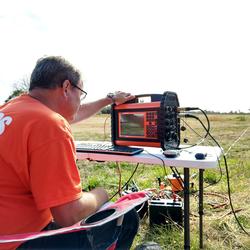Geophysics
The USGS uses an integrated geologic, hydrologic, and geophysical approach to characterize the unconsolidated and bedrock aquifers in the State. Hydrogeologic framework characterization is the backbone of most groundwater-related studies, including those involving aquifer mapping, saltwater-intrusion delineation, groundwater flow and transport modeling, geologic-hazards evaluation, water-tunnel construction and repair, geothermal assessments, and groundwater-quality sampling. The NYWSC uses state-of-the-art geophysical equipment for training and methods development for geophysics that include borehole-wall imagers, gamma spectral, induction, and full waveform sonic tools, and electromagnetic and heat-pulse flowmeters. A major recent study area is the Marcellus Shale of the Appalachian Basin, one of the largest formations that contain substantial accumulations of natural gas in the United States. Processing of the Marcellus Shale deposits, which were delineated on geophysical logs by their elevated gamma radiation and low density, require hydraulic fracturing; the NYWSC has been studying water resources issues associated with development of the Marcellus Shale deposits.












